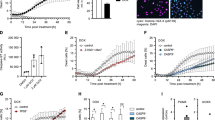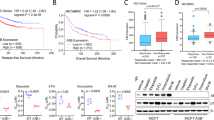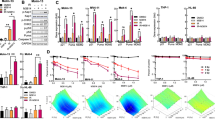Abstract
The transcription factor nuclear factor kappa-B (NF-κB) is generally regarded as an antiapoptotic factor. Accordingly, NF-κB activation inhibits death ligand-induced apoptosis. In contrast, ultraviolet light B (UVB)-induced apoptosis is not inhibited but even enhanced upon NF-κB activation by interleukin-1 (IL-1). This study was performed to identify the molecular mechanisms underlying this switch of NF-κB. Enhancement of UVB-induced apoptosis was always associated with increased release of tumour necrosis factor-α (TNF-α), which was dependent on NF-κB activation. The same was observed when UVA and cisplatin were used, which like UVB induce base modifications. In contrast, apoptosis caused by DNA strand breaks was not enhanced by IL-1, indicating that the type of DNA damage is critical for switching the effect of NF-κB on apoptosis. Surprisingly, activated NF-κB induced TNF-α mRNA expression in the presence of all DNA damage-inducing agents. However, in the presence of DNA strand breaks, there was no release of the TNF-α protein, which is so crucial for enhancing apoptosis. Together, this indicates that induction of DNA damage may have a significant impact on biological effects but it is the type of DNA damage that determines the final outcome. This may have implications for the role of NF-κB in carcinogenesis and for the application of NF-κB inhibitors in anticancer therapy.
This is a preview of subscription content, access via your institution
Access options
Subscribe to this journal
Receive 50 print issues and online access
$259.00 per year
only $5.18 per issue
Buy this article
- Purchase on Springer Link
- Instant access to full article PDF
Prices may be subject to local taxes which are calculated during checkout









Similar content being viewed by others
Abbreviations
- IκBα:
-
inhibitor of kappa-B
- IKK:
-
IκB kinase
- IL-1:
-
interleukin-1
- NF-κB:
-
nuclear factor kappa-B
- TNF-α:
-
tumor necrosis factor-α
References
Abdel-Raheem IT, Hide I, Yanase Y, Shigemoto-Mogami Y, Sakai N, Shirai Y et al. (2005). Br J Pharmacol 145: 415–423.
Armstrong BK, Kricker A . (2001). J Photochem Photobiol 63: 8–18.
Beissert S, Schwarz T . (1999). J Invest Dermatol Symp Proc 4: 61–64.
Besaratinia A, Synold TW, Chen HH, Chang C, Xi B, Riggs AD et al. (2005). Proc Natl Acad Sci USA 102: 10058–10063.
Bohuslav J, Chen L-F, Kwon H, Mu Y, Greene WC . (2004). J Biol Chem 279: 26115–26125.
Campbell KJ, Rocha S, Perkins N . (2004). Mol Cell 13: 853–865.
Chomczynski P, Sacchi N . (1987). Anal Biochem 162: 156–159.
Cornelius S, Bruynooghe Y, Van Loo G, Saelens X, Vandenbeele P, Bayaert R . (2005). Oncogene 24: 1552–1562.
Dixit V, Mak TW . (2002). Cell 111: 615–619.
Fisher GJ, Datta SC, Talwar HS, Wang ZQ, Varani J, Kang S et al. (1996). Nature 379: 335–339.
Fries W, Beyaert R, Declerq W, Vandenabeele P . (1999). Oncogene 18: 7719–7730.
Hailer MK, Slade PG, Martin BD, Rosenquist TA, Sugden KD . (2005). DNA Repair 4: 41–50.
Ho WC, Dickson KM, Barker PA . (2005). Cancer Res 65: 4273–4280.
Hoeijmakers JH . (2001). Nature 411: 366–374.
Hur GM, Lewis J, Yang Q, Lin Y, Nakano H, Nedospasov S et al. (2003). Genes Dev 17: 873–882.
Konemann S, Bolling T, Kolkmeyer A, Riesenbeck D, Hesselmann S, Vormoor J et al. (2005). Apoptosis 10: 177–184.
Kothny-Wilkes G, Kulms D, Pöppelmann B, Luger TA, Kubin M, Schwarz T . (1998). J Biol Chem 273: 29247–29253.
Kothny-Wilkes G, Kulms D, Luger TA, Kubin M, Schwarz T . (1999). J Biol Chem 274: 28916–28921.
Kulms D, Pöppelmann B, Schwarz T . (2000). J Biol Chem 275: 15060–15066.
Kulms D, Pöppelmann B, Yarosh D, Luger T A, Krutmann J, Schwarz T . (1999). Proc Natl Acad Sci USA 96: 7974–7979.
Kulms D, Schwarz T . (2002). Biochem Pharmacol 64: 837–841.
Kulms D, Zeise E, Pöppelmann B, Schwarz T . (2002). Oncogene 21: 5844–5851.
Lee JY, Hannun YA, Obeid LM . (2000). J Biol Chem 275: 29290–29298.
Mezyk R, Bzowska M, Bereta J . (2003). Acta Biochim Pol 50: 625–645.
Nakajima S, Lan L, Kanno S, Takao M, Yamamoto K, Eker AP et al. (2004). J Biol Chem 279: 46674–46677.
Panta GR, Kaur S, Cavin LG, Cortés ML, Mercurio F, Lothstein L et al. (2004). Mol Cell Biol 24: 1823–1835.
Pöppelmann B, Klimmek K, Strozyk E, Voss R, Schwarz T, Kulms D . (2005). J Biol Chem 280: 15635–15643.
Rosell R, Taron M, Barnadas A, Scagliotti G, Sarries C, Roig B . (2003). Cancer Control 10: 297–305.
Ryan KM, Ernst MK, Rice NR, Vousden KH . (2000). Nature 404: 892–897.
Sclabas GM, Uwagawa T, Schmidt C, Hess KR, Evans DB, Abbruzzese JL et al. (2005). Cancer 103: 2485–2490.
Sordet O, Kahn QA, Kohn KW, Pommier Y . (2003). Curr Med Chem 3: 271–290.
Sun NK, Huang SL, Lin-Chao S, Chao CCK . (1996). Biochem J 313: 441–445.
Thanos D, Maniatis T . (1995). Cell 80: 529–532.
Thoma B, Grell M, Pfizenmaier K, Scheurich P . (1990). J Exp Med 172: 1019–1023.
Thyss R, Virolle V, Imbert V, Peyron J-F, Aberdam D, Virolle T . (2005). EMBO J 24: 128–137.
Wajant H, Gerspach J, Pfizenmaier K . (2005). Cytokine Growth Factor Rev 16: 55–76.
Xu C, Shen G, Chen C, Gelinas C, Kong AN . (2005). Oncogene 24: 4486–4495.
Zavarski I, Jakob C, Schmid P, Krebbel H, Kaiser M, Fleissner C et al. (2005). Anticancer Drugs 16: 475–481.
Acknowledgements
We are greatful to P Scheurich, Institue of Cellbiology and Immunology, University of Stuttgart, for generous supply of FACS antibodies and antagonistic anti-TNF-R1 Fab. We thank N Peters, University of Stuttgart for exellent technical support and H Grothuesmann, University of Münster, for assistance with γ-irradiation of cells. This work was funded by the German Research Foundation, SFB 415/A16, The Federal Ministry of Environmental Protection St.Sch_4491 and the Ceries Award 2004 to TS.
Author information
Authors and Affiliations
Corresponding author
Additional information
Supplementary Information accompanies the paper on the Oncogene website (http://www.nature.com/onc)
Rights and permissions
About this article
Cite this article
Strozyk, E., Pöppelmann, B., Schwarz, T. et al. Differential effects of NF-κB on apoptosis induced by DNA-damaging agents: the type of DNA damage determines the final outcome. Oncogene 25, 6239–6251 (2006). https://doi.org/10.1038/sj.onc.1209655
Received:
Revised:
Accepted:
Published:
Issue Date:
DOI: https://doi.org/10.1038/sj.onc.1209655
Keywords
This article is cited by
-
miRNA-214-3p stimulates carcinogen-induced mammary epithelial cell apoptosis in mammary cancer-resistant species
Communications Biology (2023)
-
Anti-Apoptotic NF-κB and “Gain of Function” mut p53 in Concert Act Pro-Apoptotic in Response to UVB+IL-1 via Enhanced TNF Production
Journal of Investigative Dermatology (2015)
-
Development of a human three-dimensional organotypic skin-melanoma spheroid model for in vitro drug testing
Cell Death & Disease (2013)
-
Loss of PIDD limits NF-κB activation and cytokine production but not cell survival or transformation after DNA damage
Cell Death & Differentiation (2013)
-
The diverse and complex roles of NF-κB subunits in cancer
Nature Reviews Cancer (2012)



